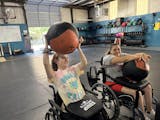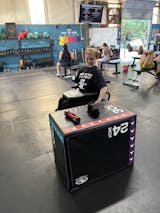Adaptive Jump Ropes and How They Work
But what if you're in a wheelchair? Missing a hand or arm? Recovering from joint or balance issues—or coming back from a surgery or injury?
That’s where adaptive jump ropes come in. At EquipProducts.com, we specialize in adaptive fitness and physical therapy tools—built by and for athletes of all abilities. Here are five ways to get the benefits of jump rope training without traditional limitations.
1. Multi Rope™ – Seated Jump Rope Training
The Multi Rope™ from Equip Products is our signature adaptive jump rope. Designed for seated athletes, the Multi Rope™ uses high-speed bearing handles (just like the pros) with your choice of 1/2", 3/4", or twisted 1/2" ropes.
You rotate the rope while seated, tapping it on the ground for every pass. It lights up your forearms, then ignites your core. Whether you’re warming up or doing a full HIIT circuit, the Multi Rope™ is a favorite among adaptive athletes and physical therapists.
See it in action: Multi Rope Demo
2. Mono Rope™ – Jumping with One Arm
Missing a hand or arm? No problem.
The Mono Rope™ is built for single-arm athletes and uses a compact aluminum bar fitted with jump rope eyelets and high-speed bearings. A center grip allows you to rotate the entire rope using just one hand.
It’s used in elite adaptive competitions for single-arm double-unders, crossovers, and more. The Mono Rope™ opens up a new world of cardio, skill, and confidence.
Here are some good examples: Mono Rope Users
3. Arm Cuff Jump Rope – Secure Grip for Amputees
Our Arm Cuff Jump Rope is built with a PE foam liner, ratchet-style ski boot strap, and durable leather wrap—allowing users with residual limbs to secure the rope directly to their arm.
Once in place, it works like a traditional jump rope—with both hands spinning in unison. Athletes with limb loss or congenital differences use it in CrossFit boxes and competitions worldwide.
Here is an example: Ginny Using the Arm Cuff
4. Monster Rope – Heavy Duty Seated Conditioning
The Monster Rope comes in two diameters: 1.5" and 2.0". It’s ideal for seated use (plyo box, wheelchair, bench), where athletes create massive rotational energy by swinging the rope forward and backward overhead.
This motion challenges grip, shoulder flexibility, and cardio endurance—especially when reversing direction. It’s a shoulder-opener and total-body burner.
Here is an example: Kevin Ogar Using the Monster Rope
5. Heavy Multi Rope™ & Heavy Mono Rope – Max Resistance
Once you’ve mastered the basics, level up with the Heavy Multi Rope™ or Heavy Mono Rope. These beasts are made with 1.5" or 2" hemp-style ropes and extra-tough handles.
Grip strength, core stability, cardio output—these ropes are the top of the adaptive training pyramid.
Watch these highlights: 2024 CrossFit Adaptive Games Heavy Ropes
Adaptive Jump Ropes That Work for You
Equip Products is committed to building adaptive jump ropes and inclusive fitness equipment for every body. Whether you're working on mobility, therapy, or athletic performance, our designs help you move better and live stronger.
Explore the full collection at EquipProducts.com and join the movement.
#AdaptiveJumpRope #SeatedFitness #MonoRope #MultiRope #EquipProducts #DisabilityFitness #AdaptiveAthlete #MadeInUSA #JumpRopeTraining



